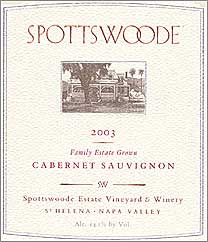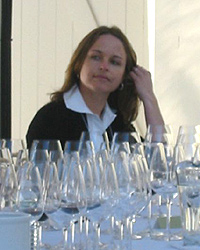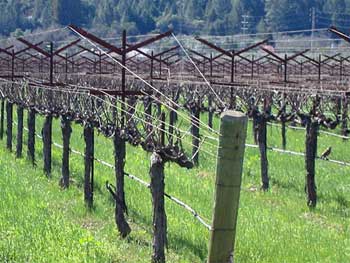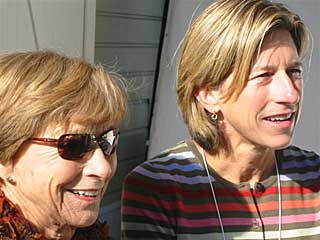

Spottswoode Estate Vineyards & Winery recently held a 25 year vertical tasting of its terroir-infused Cabernets.
Spottswoode: A Napa Valley First Growth
With the 75th anniversary of the repeal of Prohibition upon us next year, and in the 15th year (give or take a few) into the Post-Phylloxera Era, it may seriously be the right moment to take a good, hard look at the notion of creating a Classification of Napa Valley. A 25-year vertical tasting of Spottswoode Cabernets puts that into perspective.
by
Alan Goldfarb
February 26, 2007
From the first wine released by this St. Helena producer in 1982 to the present – a barrel sample of the 2006 vintage – there is a marked consistency, even though the wine has been shepherded over a quarter century by a quartet of well-regarded winemakers. Therefore, one must conclude, that it is the site on the bench-land of the Mayacamas Range (or as Spottswoode’s longtime vineyard consultant David Abreu refers to it, “the toe of the hills”) at mid-valley, which is the nexus of Spottswoode having produced great Cabernets.
The 40-acre vineyard, which even now is undergoing replanting due to phylloxera, and which has seen new clones and rootstocks, has certainly changed since 1991. But 80 percent of its original scion (grafted) wood has protected the integrity of the vines, and the same trellis system has been in place since before the Novak family bought the parcel for $2,000 an acre in 1972. Additionally, the vineyard – which sits in the middle of a residential neighborhood west of downtown St. Helena -- has been farmed organically since 1985.
The estate is also situated in what is perhaps the warmest spot in the Napa Valley. To further protect the vines, which produce a preponderance of Cabernet (there are less than three acres of Cabernet Franc, less than an acre of Petit Verdot, and no Merlot), the aforementioned trellising is absolutely integral to the success of the wine.

Spottswoode Estate winemaker, Jennifer Williams
The system, pragmatically called an “open V cross-arm,” serves to cloister the grapes from the scorching sun. Actually shaped more like a “Y” than a “V”, the trellis is not a VSP or vertical shoot position system, which is ubiquitous throughout the region.
Current Spottswoode winemaker Jennifer Williams, who took over with the 2006 vintage from Rosemary Cakebread, who had been at the helm since ’97, (Tony Soter was winemaker from ’92-’91 and Pam Starr was the winemaker from ’92-’96) believes that the open V cross-arm – with moveable wires which force the canes to take on a “Y” shape -- allows shade for the fruit on both sides.
“We prevent fruit burn with this trellis. It could be a pretty hot site in the dead of summer. We need that ability for shade,” says Williams, who doubles as Spottswoode’s vineyard manager. “The most important thing is you’re not going to see desiccation and sunburn, which will change the quality of the fruit.”
Soter, who still consults on the project, thinks that the VSP is absolutely not the right trellis system for much of the Napa Valley. “The VSP has been put in (throughout the valley, but not at Spottswoode) because it acts as a solar panel,” says Soter, who has recently moved to Oregon where he is making Pinot Noir, after spending 30 years in the Napa Valley. “I think it’s not an appropriate trellis for this climate. We need a system that’s more spread out.”

Pragmatically called an “open V cross-arm,” the trellis system serves to cloister the grapes from the scorching sun.
Soter noted the trellis system in a discussion of a possible stylistic change in Spottswoode’s wines since ’97, which fell under Cakebread’s and now Williams’ watches. Whereas the wines preceding ’97 exhibited definitive acidity, the younger wines may be perceived by some as having less acid. “I asked (myself), ‘where that nervy acid edge went’ …” acknowledges Soter, after he tasted all the wines and came to the second flight of younger wines.
He placed it at the feet of climate change. “I swear, 10, 15 years ago that out here these grapes were ripe enough (earlier). I can be out in the same field now and I can be shocked at the (higher) numbers … There is a component of climate change.”
So How Are Spottswoode Cabernets Tasting Now?
Nonetheless, after I went through the 25 wines in two flights from ’82 to ’96 and from ’97 to the present, I didn’t note a stylistic change; only that the wines from ’97 exhibit fresher, brighter fruit due to their relative youth; and that the acidity will emerge as with the older vintages.Overall, the Spottswoode Cabernets over a quarter-century show remarkable consistency of quality, as well as style. My impressions are that they are:
- Greatly balanced.
- Display red fruit (i.e. black raspberry).
- Have restrained oak.
- Show the minerality from the vineyard’s proximity to Sulfur Creek and the sandy clay loam.
- Have remarkable acidity.
- And they are not overwhelmed by alcohol. (From the ‘80s-’01, the listed alcohol percentages were in the mid-13s; from ’03-’06, they are in the mid-14s (see Soter’s climate change theory); and they were at their highest – 14.8 – in ’02.).

Mary Novak (left) with daughter Beth Novak Milliken.
But, save for the possible exceptions of the 2000 and the ’01, which are softer in style, Spottswoode’s Cabernets are right where they ought to be – not feminine, not masculine. Just right down the middle, and in balance.
“Our vision since the beginning is to produce wines of their grape origin,” says Novak Milliken. “Tony coined that, and we’re trying to adhere to that. Over time, we hope to establish this piece of ground – if we do our jobs well – as one of the best vineyards in the world.”
Is Spottswoode a first growth? Does it deserve top status? You bet it does.
~ Alan Goldfarb, Regional Correspondent
For more on Spottswoode 25th anniversary read Dan Berger’s Keepers of the Terroir.










 READER FEEDBACK: To post your comments on this story,
READER FEEDBACK: To post your comments on this story,




